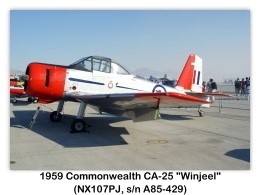

























Commonwealth CA-25 Winjeel
Single-engine two-side-by-side-seats tail-dragger low-wing training monoplane, Australia
Archive Photos 1
1959 Commonwealth CA-25 "Winjeel" (NX107PJ, s/n A85-429) at the 2009 Cable Air Show, Cable Airport, Upland, CA (Photos by John Shupek)














1959 Commonwealth CA-25 "Winjeel" (NX107PJ, s/n A85-429) at the Commonwealth CA-25 Winjeel, NX107PJ, mfg 1959, sn A85-429, Nellis 2007 Airshow (Photos by John Shupek)

Overview 2
- Commonwealth CA-25 Winjeel
- Role: Trainer aircraft
- National origin: Australia
- Manufacturer Commonwealth Aircraft: Corporation
- Introduced: 1955
- Retired: 1994
- Status: Some examples now privately owned or in museums
- Primary: user Royal Australian Air Force
- Number built: CA-22(2); CA-25 (62)
The CAC CA-25 "Winjeel" (aboriginal for young eagle) entered service with the Royal Australian Air Force in 1955 as an ab-initio to advanced trainer aircraft.
Design and Development 2
The Winjeel was developed by the Commonwealth Aircraft Corporation at Fishermans Bend in Victoria to satisfy RAAF technical requirement No.AC.77. 62 aircraft were built and given the fleet serials A85-401 to A85-462. The first entered service with No.1 Basic Flight Training School (BFTS) at Uranquinty, near Wagga-Wagga, New South Wales. The aircraft remained in service with the RAAF as a trainer until 1977. A small number of Winjeels were used as Forward Air Control (FAC) from 1977 until being removed from service in the early 1990s. They was also used in the FAC training role before being replaced by the PC-9 in 1994. Examples of the aircraft remain in flying condition in private hands as well as museum displays around the country.
Variants 2
- CA-22 Winjeel: Prototypes. Only two aircraft were built.
- CA-25 Winjeel: Two-seat basic trainer aircraft for the RAAF. 62 aircraft were built.
Operators 2
- Australia: Royal Australian Air Force
Commonwealth CA-25 Winjeel Specifications 3
The Commonwealth CA-25 Winjeel, which was first flow on February 23, 1955, is the production version of the Commonwealth CA-22, the prototype Winjeel, which made its maiden flight in 1950. The name "Winjeel" comes from an aboriginal word meaning "Eagle". Production of 62 Winjeels for the Royal Australian Air Force (RAAF) was completed in 1958.
Type
Wings
- Low-wing cantilever monoplane.
- Wing section NACA 23015 at root tapering to NACA 23009 at tip, with negative twist of 2½°.
- Aspect ratio 6.
- Mean chord 6 ft 5 in (1.96 m)
- Dihedral, outer wings: 5°
- Two-spar aluminum-alloy structure.
- All-metal electrically-operated trailing-edge flaps between ailerons, including section beneath fuselage.
- Frise type ailerons have metal frames and fabric covering.
- Total flap area: 33.61 ft² (3.12 m²)
- Total aileron area: 13.78 ft² (1.28 m²)
- Gross wing area: 249 ft² (23.13 m²)
Fuselage
- Aluminum-alloy semi-monocoque structure.
Tail Unit
- Cantilever monoplane type.
- Metal frames with metal-covered fixed surfaces and fabric-covered rudder and elevators.
- Elevators have trailing-edge servo and trim tabs.
- Rudder has trim-tab only.
- Areas: Fin 9.42 ft² (0.88 m²); Rudder: 9.25 ft² (0.86 m²); Tailplane: 46.5 ft² (4.32 m²); Elevators: 20.19 ft² (1.88 m²)
- Tailplane span: 14 ft (4.27 m)
Landing Gear
- Fixed tail-wheel type.
- Cantilever long-stroke oleo-pneumatic shock-absorber struts.
- Dunlop wheels with hydraulic single-disc brakes.
- Free swivelling steerable tail wheel.
- Track: 10 ft 1 in (31.07 m)
Powerplant
- One 445-hp (331.84 kW) Pratt & Whitney R 985 AN2 Wasp Junior nine-cylinder radial air-cooled engine on welded steel-tube mounting.
- Mounting attached to fireproof bulkhead by four bolts and quickly removable.
- Cowling in four opening panels hinged at the firewall for complete engine accessibility.
- Hamilton Standard two-blade variable pitch airscrew.
- Two flexible bag tanks (34.5 Imp-gallons; 157 L each) between spars in center section.
- Auxiliary fuselage tank may be carried beneath center-section (30 Imp. Gallons; 136 L).
Accommodation
- Enclosed cockpit seats three, two side-by-side with dual controls in front, plus third seat for additional pupil aft.
- Radio compartment beside rear seat.
- Sliding canopy may be jettisoned in emergency.
- Amber screening for blind flying training.
Dimensions
- Span: 38 ft 7½ in (11.77 m)
- Length: 28 ft 0½ in (8.55 m)
- Height: 9 ft 1 in (2.77 m)
Weights and Loadings
- Weight empty: 3,289 lb (1,492 kg)
- Removable equipment: 34 lb (15 kg)
- Crew (2): 400 lb (182 kg)
- Fuel (69 Imp. gallons) and oil (5 Imp. gallons): 542 lb (246 kg)
- Weight loaded: 4,265 lb (1,935 kg)
- Wing loading: 17.1 psf (83.45 kg/m²)
- Power loading: 9.58 lb/hp (4.34 kg/hp)
Performance
- Max. speed: 186 mph (299 km/h)
- Cruising speed at 8,500 ft (2,590 m): 165 mph (265 km/h)
- Rate of climb at T/O power: 1,500 ft/min (458 m/min)
- Rate of climb at rated power: 1,130 ft/min (344 m/min)
- Climb to 5,000 ft (1,525 m) at rated power: 4.6 min.
- Climb to 10,000 ft (3,050 m) at rated power: 10 min.
- Service ceiling: 18,000 ft (5,490 m)
- Stalling speed (flaps down): 53 mph (85 km/h)
- Stalling speed (flaps up): 62 mph (100 km/h)
- Take off distance (standard temp.): 540 ft (165 m)
- Take off distance (tropical temp.): 630 ft (192 m)
- Take off distance to clear 50 ft. (15.25 m) (standard temp.): 1,110 ft (338 m)
- Take off distance to clear 50 ft. (15.25 (tropical temp.): 1,260 ft (384 m)
- Landing distance from 50 ft. (15.25 m) (standard temp.): 1,000 ft (305 m)
- Cruising endurance (69 Imp. gal.): 3-1/2 hours at 158 mph (253 km/h) at 5,000 ft. (1,525 m)
References
- Photos: John Shupek
- Wikipedia, the free encyclopedia. CAC Winjeel
- Bridgman, Leonard (ed.) Jane’s All The World’s Aircraft 1958-59. London, Jane’s All The World’s Aircraft Publishing Co. Ltd., 1958, pp 118.
































































